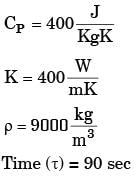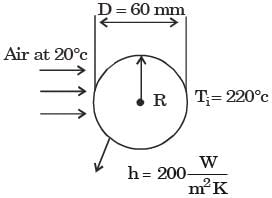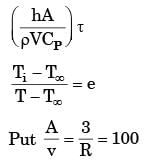Past Year Questions: Fins And Unsteady Heat Transfer (Conduction And Convection) - Mechanical Engineering MCQ
15 Questions MCQ Test Additional Study Material for Mechanical Engineering - Past Year Questions: Fins And Unsteady Heat Transfer (Conduction And Convection)
Two rods, one of length L and the other of length 2L are made of the same material and have the same diameter. The two ends of the longer rod are maintained at 100°C. One end of the shorter rod is maintained at 100°C while the other end is insulated. Both the rods are exposed to the same environment at 40°C. The temp at the insulated end of the shorter rod is measured to be 55°C. The temperature at the mid point of the longer rod would be.
[1992]
A fin has 5 mm diameter and 100 mm length. The thermal conductivity of fin material is 400 Wm–1K–1. One end of the fin is maintained at 130°C and its remaining surface is exposed to ambient air at 30°C. If the convective heat transfer coefficient is 40 Wm–2K–1, the heat loss (in W) from the fin is
[2010]
| 1 Crore+ students have signed up on EduRev. Have you? Download the App |
Which one of the following configurations has the highest fin effectiveness?
[2012]
The heat transfer process between body and its ambient is governed by an Intemal Conductive Resistance (ICR) and an External Convective Resistance (ECR). The body can be considered to be a lumped heat capacity system is
[1989]
Biot number signifies
[1991]
Lumped heat transfer analysis of a solid object suddenly exposed to a fluid medium at a different temp is valid when
[2001]
The value of Biot number is very small (less than 0.01),when
[2002]
A spherical thermocouple junction of diameter 0.706 mm is to be used for the measurement of temperature of a gas stream. The convective heat transfer coefficient on bead surface is 400 W/m2K, Thermophysical properties of thermocouple material are k = 20 W/mK, c = 400 J/kgK and r = 8500 kg/m3. If the thermocouple initially at 30°C is placed in a hot stream of 300°C, the time taken by the bead to reach 298°C, is
[2004]
A small copper ball of 5 mm diameter at 500 K is dropped into an oil bath whose temperature is 300 K. The thermal conductivity of copper is 400 W/mK, its density 9000 kg/m3 and its specific heat 385 J/kgK. If the heat transfer coefficient is 250 W/m2K and lumped analysis is assumed to be valid, the rate of fall of the temperature of the ball at the beginning of cooling will be, in K/s,
[2005]
The average heat transfer coefficient on a thin hot vertical -plate suspended in still air can be determined from observations of the change in plate temperature with time as it cools. Assume the plate temperature to be uniform at any instant of time and radiation heat exchange with the surroundings negligible. The ambient temperature is 25°C, the plate has a total surface area of 0.1 m2 and a mass of 4 kg. The specific heat of the plate material is 2.5 kJ/kgK. The convective heat transfer coefficient in W/m2K, at the instant when the plate temperature is 225°C and the change in plate temperature with time dT/dt = – 0.02 K/s, is
[2007]
Consider steady-state heat conduction across the thickness in a plane composite wall (as shown in the figure) exposed to convection conditions on both sides. Given: hi = 20 W/m2K; h0 = 50 W/m2K; T∝i = 20°C; T∝,0 = -2°C; k1 = 20 W/mK; k2 = 50 W/mK; L1 = 0.30 m and L2 = 0.15 m. Assuming negligible contact resistance between the wall surfaces, the interface termperature, T(in °C), of the two walls will be
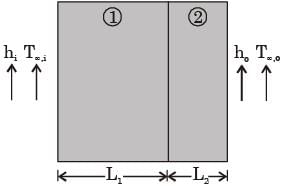
[2009]
A spherical steel ball of 12 mm diameter is initially at 1000 K. It is slowly cooled in a surrounding of 300 K. The heat transfer coefficient between the steel ball and the surroundings is 5 W/m2K. The thermal conductivity of steel is 20 W/mK. The ternperature difference between the centre and the surface of the steel ball is
[2011]
A steel ball of diameter 60 mm is initially in thermal equilibrium at 1030°C in a furnace. It is suddenly removed from the furnace and cooled in ambient air at 30°C, with convective heat transfer coefficient h = 20 W/m2K. The thermophysical properties of steel are : density ρ = 7800 kg/m2, conductivity k =40 W/mK and specific heat c - 600 J/kgK. The time required in seconds to cool the steel ball in air from 1030°C to 430°C is
[2013]
Biot number signifies the ratio of
[2014]
A metal ball of diameter 60 mm is initially at 220°C. The ball is suddenly cooled by an air jet of 20°C. The heat transfer coefficient is 200 W/m2K. The specific heat, thermal conductivity and density of the metal ball are 400 J/kgK, 400 W/mK and 9000 kg/m3, respectively. The ball temperature (in °C) after 90 seconds will be approximately
[2017]
|
1 videos|30 docs|57 tests
|
|
1 videos|30 docs|57 tests
|





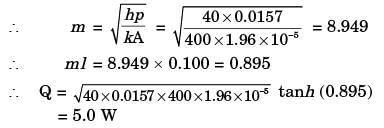
 for desired condition i.e. Bi < 0
for desired condition i.e. Bi < 0
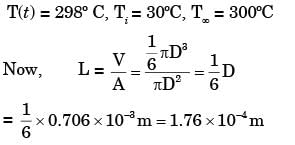

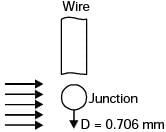
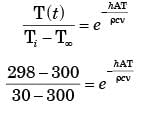
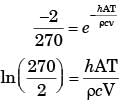
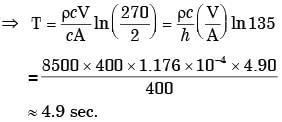

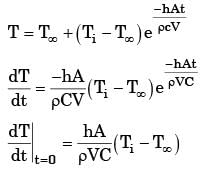













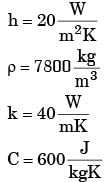
 ...(i)
...(i) 


